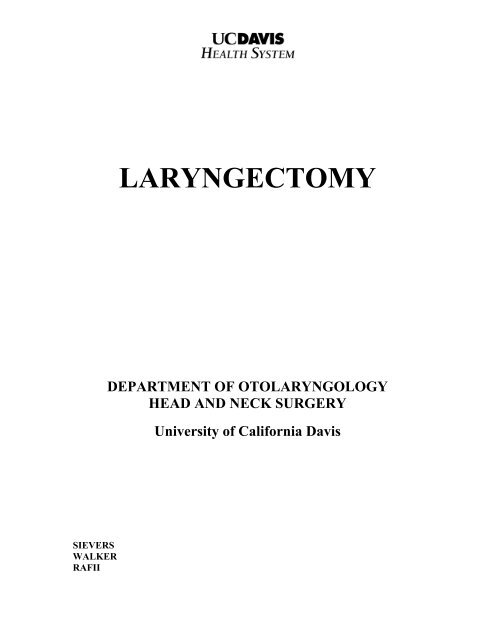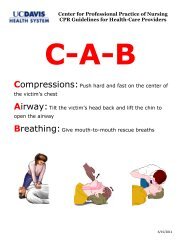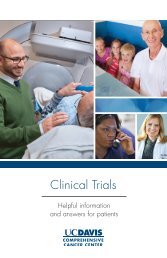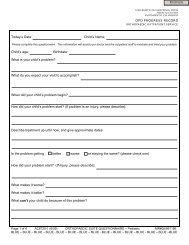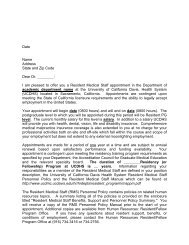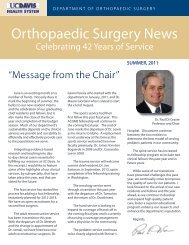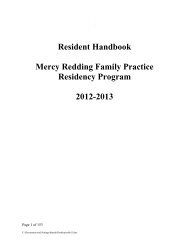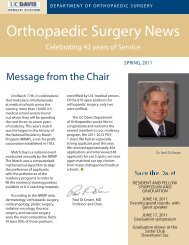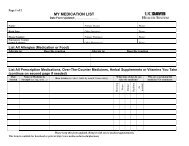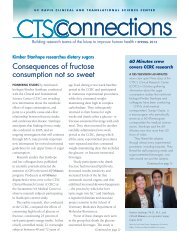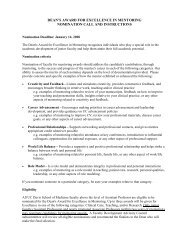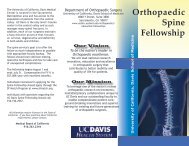Laryngectomy - UC Davis Health System - University of California ...
Laryngectomy - UC Davis Health System - University of California ...
Laryngectomy - UC Davis Health System - University of California ...
You also want an ePaper? Increase the reach of your titles
YUMPU automatically turns print PDFs into web optimized ePapers that Google loves.
SIEVERS<br />
WALKER<br />
RAFII<br />
LARYNGECTOMY<br />
DEPARTMENT OF OTOLARYNGOLOGY<br />
HEAD AND NECK SURGERY<br />
<strong>University</strong> <strong>of</strong> <strong>California</strong> <strong>Davis</strong>
IMPORTANT PHONE NUMBERS<br />
CHAPTER 1: DIAGNOSIS<br />
TNM STAGING<br />
TABLE OF CONTENTS<br />
CHAPTER 2: TREATMENT OF CANCER<br />
CHAPTER 3: ANATOMY<br />
NORMAL ANATOMY<br />
ANATOMY AFTER LARYNGECTOMY<br />
CHAPTER 4: THE SURGERY<br />
TOTAL LARYNGECTOMY<br />
NECK DISSECTION<br />
RECONSTR<strong>UC</strong>TION<br />
CHAPTER 5: THE HOSPITAL STAY<br />
ENT NURSING FLOOR<br />
CHAPTER 6: HOME<br />
CHAPTER 7: SPEECH OPTIONS<br />
APPENDIX<br />
STOMA CARE<br />
DO’S AND DON’TS FOR LARYNGECTOMEES<br />
SALINE RECIPE<br />
WEB INFORMATION<br />
CALIFORNIA CLUBS<br />
DISCHARGE INSTR<strong>UC</strong>TIONS AND PHONE NUMBER<br />
Page 3<br />
Page 4<br />
Page 5<br />
Page 6<br />
Page 8<br />
Page 11<br />
Page 13<br />
Page 16<br />
Page 20<br />
2
ENT CLINIC<br />
Physician<br />
Radiation Oncology<br />
Medical Oncology<br />
MD Fellow<br />
MD Resident<br />
ENT Nurse<br />
Advice Nurse – Clinic<br />
Discharge Planner<br />
Speech Pathology<br />
Dietician<br />
Physical Therapy<br />
Social Service<br />
<strong>UC</strong>DAVIS<br />
<strong>UC</strong>DAVIS<br />
EMERGENCY ROOM<br />
<strong>UC</strong>DAVIS TOWER 4<br />
ENT NURSING UNIT<br />
IMPORTANT NAMES AND PHONE NUMBERS<br />
<strong>UC</strong>DAVIS TOWER 7<br />
ENT INTENSIVE CARE UNIT<br />
******add <strong>UC</strong>DHS map<br />
Name Phone Number<br />
916 AREA CODE<br />
Otolaryngology<br />
734-5400<br />
Head and Neck<br />
and Skull Base Surgery<br />
Paul Donald MD<br />
734-5400<br />
Danny Enepekides MD<br />
D Gregory Farwell MD<br />
<strong>UC</strong> <strong>Davis</strong> Cancer Center 734-5820<br />
<strong>UC</strong> <strong>Davis</strong> Cancer Center 734-5991<br />
Clinic <strong>of</strong>fice 734-5400<br />
Clinic <strong>of</strong>fice 734-5400<br />
Ann Sievers RN MA CORLN 734-5400 or 734-2120 VM<br />
Pam Green RN 734-5400 or 734-1965<br />
Discharge Planning Office<br />
Main Hospital<br />
734-2944<br />
ENT Speech <strong>of</strong>fice 734-5400<br />
Bev Lorens RD MS 734-2442<br />
Physical Therapy Office 734-6700<br />
Office 734-2234<br />
Phone Number<br />
916 AREA CODE<br />
734-2011<br />
Main Operator<br />
734-3333<br />
734-5680<br />
3
CHAPTER 1<br />
DIAGNOSIS and TNM STAGING<br />
The diagnosis <strong>of</strong> cancer will affect your life. You will have choices and options for treatment.<br />
You will have information and support about the cancer and how to deal with this diagnosis.<br />
Your treatment options depend on the location, type, and size <strong>of</strong> your cancer. Your options also<br />
depend on your general health as well as your wishes for care.<br />
Many discussions with your physicians, treating team, your friends and family will help you<br />
decide what choice to make. It is your choice to choose the therapy you want for yourself.<br />
The cause <strong>of</strong> head and neck cancer is <strong>of</strong>ten related to smoking, chewing tobacco, and alcohol.<br />
Other environmental causes have been identified but are not major risks. Smoking and alcohol<br />
also cause other medical problems that affect your health and recovery.<br />
TNM STAGING<br />
T = Tumor 1, 2, 3, or 4<br />
N = Node or lymph nodal disease Many categories<br />
M = Metastatic disease Cancer in other organ systems<br />
Stage = Classification Extent <strong>of</strong> disease<br />
Survival Usually a % based on 5 year survival<br />
statistics<br />
Your Stage<br />
Your type <strong>of</strong> cancer<br />
The location <strong>of</strong> your cancer<br />
YOUR TNM<br />
T N M<br />
Stage<br />
Much <strong>of</strong> your recovery depends on your willingness to learn and accept the changes<br />
following laryngectomy.<br />
4
CHAPTER 2<br />
TREATMENT OF CANCER<br />
There are many ways to treat cancer.<br />
Your treatment depends on the type <strong>of</strong> cancer and your individual response. It<br />
also depends on the location and the size <strong>of</strong> the cancer. Have your physician write down<br />
the type <strong>of</strong> cancer and the specific location. Your treatment plan is for you alone.<br />
Everyone is different and your cancer is unique to you alone. You have many<br />
choices and it is important to discuss these choices with your physician and your family.<br />
It is your choice. Discuss the choice with your ENT Surgical Oncologist.<br />
TYPES OF THERAPY FOR HEAD AND NECK CANCER<br />
SURGERY<br />
Surgery alone or followed by Radiation therapy, or following<br />
other treatments.<br />
If you choose surgery you will be in the hospital for about 2-14<br />
days depending on your type <strong>of</strong> surgery.<br />
RADIATION Radiation alone or in combination with surgery or<br />
chemotherapy<br />
CHEMOTHERAPY<br />
COMBINATION<br />
THERAPY<br />
Radiation is commonly 6 -7 weeks long, 5 days a week and<br />
done as an outpatient.<br />
The first session is for treatment planning and lasts about 2<br />
hours. Daily treatments last about 10 minutes. Sometimes people<br />
have twice daily treatments<br />
Radiated tissue does not heal well, so nutrition is important.<br />
A Radiation Oncologist gives radiation therapy and will discuss<br />
the treatments with you.<br />
Speech and swallowing therapy is important during your<br />
Radiation treatments.<br />
Chemotherapy is usually used in combination with radiation<br />
therapy.<br />
Chemotherapy is most <strong>of</strong>ten given as an outpatient.<br />
A Medical oncologist gives chemotherapy and will discuss the<br />
treatments with you.<br />
This therapy is a combination <strong>of</strong> the above treatments.<br />
5
PROTOCOL<br />
THERAPY<br />
These are carefully controlled and supervised studies. You may<br />
be asked to participate in research studies about different kinds<br />
<strong>of</strong> cancer treatments. These are controlled or experimental<br />
studies. Discuss the possibility <strong>of</strong> enrolling in a study with your<br />
physician.<br />
6
CHAPTER 3<br />
NORMAL ANATOMY<br />
In your head and neck you have two natural tubes in your body, one for eating and one<br />
for breathing. The food tube is the esophagus. The breathing tube is the larynx (voice<br />
box) and the trachea. Breathing and swallowing share the same structures in the back <strong>of</strong><br />
the mouth and throat. In your head and neck area the breathing tube is in front <strong>of</strong> the<br />
swallowing tube.<br />
We eat through our mouth, into the throat, down the esophagus and into the stomach. We<br />
breathe through our nose and mouth. Air goes through the nose and mouth, through the<br />
voicebox (larynx), down the windpipe (trachea), and connects to the lungs. We smell<br />
through our nose and we taste in our mouth. Our mouth senses the food texture,<br />
temperature and type. Smell and taste are important and can change after surgery,<br />
radiation, and chemotherapy.<br />
NORMAL BREATHING<br />
You breathe through your nose and sometimes through your mouth. Air follows a path<br />
through the voice box (larynx) and into the lungs. Your lungs use the air to give oxygen<br />
to the body. You exhale through your mouth and nose.<br />
NORMAL SPEECH<br />
You use your voice box (larynx) to produce sound. Your tongue and mouth shape the<br />
sounds to produce words and speech. In normal speech, the vocal folds (sometimes called<br />
the vocal cords in the larynx), vibrate, and sound is produced just like a musical<br />
instrument. This is important to remember for speech therapy after your surgery.<br />
NORMAL SWALLOWING<br />
Normal swallowing moves food from your mouth to your food tube (esophagus) into the<br />
stomach. Your mouth prepares the food, mixes it with saliva, and with strong muscles<br />
moves it through the esophagus into the stomach.<br />
7
ANATOMY AFTER LARYNGECTOMY<br />
BREATHING AFTER LARYNGECTOMY<br />
After laryngectomy (removal <strong>of</strong> your voice box) you will breathe through a small hole in<br />
the front <strong>of</strong> your neck. This hole or stoma is about the size <strong>of</strong> a nickel. Your natural<br />
pathway for breathing is changed but you will breathe easily from your new airway. Air<br />
goes directly into your lungs through your new stoma.<br />
SPEECH AFTER LARYNGECTOMY<br />
After laryngectomy you will never produce your normal voice sounds. A speech<br />
pathologist will help you learn different ways to speak. Your voice changes because your<br />
larynx, (voice box) is removed. Immediately after surgery you will communicate by<br />
writing, gestures, hand signals, and facial expressions. There are many ways to<br />
communicate after laryngectomy. You and your speech pathologist will work together to<br />
learn to communicate using many different types <strong>of</strong> techniques.<br />
Refer to Chapter 7 on speech rehabilitation.<br />
SWALLOWING AFTER LARYNGECTOMY<br />
Your swallowing will change because the surgery to remove your voice box also affects<br />
your swallowing tube. Your breathing and food tube are now completely separate.<br />
Immediately following surgery you will eat through a tube. The tube goes from your nose<br />
to your stomach, or it can go directly into your stomach. This tube allows your inside<br />
incisions to heal. The goal is to swallow after treatment and healing. Good nutrition is<br />
very important for every person with cancer.<br />
Normal Anatomy After <strong>Laryngectomy</strong><br />
8
CHAPTER 4<br />
THE SURGERY<br />
TOTAL LARYNGECTOMY<br />
The size and type <strong>of</strong> your cancer determines the size and type <strong>of</strong> your surgery.<br />
Depending on the size <strong>of</strong> your cancer the surgery to remove your larynx will take from 4<br />
to 8 hours. Discuss in detail with your physician how long your surgery will take.<br />
My surgery will take about _______________hours<br />
The most important part <strong>of</strong> your surgery is to remove the cancer. Another important part<br />
is to create your stoma. You will permanently breathe through your stoma. The stoma is a<br />
nickel size opening in the front <strong>of</strong> your neck that connects directly to your lungs.<br />
The removal <strong>of</strong> your voice box (larynx) takes away your ability to talk the same way you<br />
did before surgery<br />
NECK DISSECTION<br />
You may need a neck dissection if the cancer has spread or has a high likelihood <strong>of</strong><br />
spread to your lymph glands in your neck. Neck dissection is the removal <strong>of</strong> some <strong>of</strong> the<br />
lymph glands in the neck, left, right or both necks. You normally have over 100 lymph<br />
glands in each neck. Their job is to filter the lymph fluid, fight infections, and filter the<br />
cancer. Removing cancerous lymph nodes is part <strong>of</strong> the complete surgery.<br />
Ask if this is part <strong>of</strong> your treatment plan. Ask what type <strong>of</strong> neck dissection you will need.<br />
The type depends on the extent <strong>of</strong> cancer. If you have a formal neck dissection you may<br />
have shoulder weakness. This is because <strong>of</strong> the removal <strong>of</strong> a major nerve in the shoulder.<br />
Physical therapy exercises will help you recover. It is important to do these exercises!<br />
9
Your laryngectomy and/or neck dissection incision may look like this:<br />
Surgical Anatomy Diagram<br />
10
RECONSTR<strong>UC</strong>TION/ REPAIR<br />
Another important part <strong>of</strong> the surgery is reconstruction following the removal <strong>of</strong><br />
the cancer. The kind <strong>of</strong> reconstruction depends on the size <strong>of</strong> your cancer and the<br />
location. Discuss with your physician what type <strong>of</strong> reconstruction is best for you.<br />
One way is to let you heal naturally. If necessary, extra tissue from other parts <strong>of</strong><br />
your body fills the space where the cancerous tissue has been removed. These tissues will<br />
help fill in the spaces missing after removing the cancer. Sometimes these new tissues<br />
help perform some <strong>of</strong> the functions the original tissue performed.<br />
Primary reconstruction<br />
Pectoralis major flap<br />
Free flap – radial forearm<br />
Free flap – lateral thigh<br />
Free flap – rectus<br />
TYPES OF RECONSTR<strong>UC</strong>TION<br />
Letting you heal by yourself with some suturing inside and<br />
outside.<br />
Taking skin and muscle from the front <strong>of</strong> your chest to<br />
reconstruct the surgical defect<br />
Skin, muscle, artery and vein from your forearm<br />
Skin, muscle, artery and vein from your lateral thigh<br />
Skin, muscle, artery and vein from your abdominal area<br />
Free flap - scapula Skin, muscle, artery and vein and bone from your upper back<br />
MY TYPE OF RECONSTR<strong>UC</strong>TION IS:<br />
11
POSSIBLE CONCERNS / COMPLICATIONS<br />
Anytime a person has cancer and treatments for cancer there are possible concerns<br />
and possible complications due to the cancer and the therapy. Discuss in detail with your<br />
physician some <strong>of</strong> your concerns about the diagnosis and therapy. Your physician and<br />
treating team will discuss the concerns <strong>of</strong> your specific cancer treatment with you.<br />
This is part <strong>of</strong> what is called informed consent. Discuss also what would likely<br />
happen if you choose no treatment for your cancer.<br />
Possible Concerns Possible Causes<br />
Wound healing problems<br />
Poor nutrition, smoking, alcohol, certain<br />
medications, age, pre-radiation therapy.<br />
Reconstruction Flap failure<br />
Poor nutrition, decrease in blood flow,<br />
Smoking<br />
Fistula: communication between two Prior radiation therapy, poor nutrition,<br />
structures<br />
infection<br />
Cardiac heart problems Smoking, alcohol withdrawl, age<br />
Bleeding Aspirin, herbs, NSAID’s(like Ibupr<strong>of</strong>en©,<br />
Advil©, Motrin© )<br />
Lung problems pneumonia Smoking<br />
Stroke Smoking ,cancer, vascular disease, age<br />
Nutrition, weight loss Cancer, poor eating habits, age<br />
Alcohol withdrawal Excess alcohol before surgery<br />
Tobacco withdrawal Tobacco use before surgery<br />
Caffeine withdrawal Excess caffeine before surgery<br />
12
CHAPTER 5<br />
THE HOSPITAL STAY<br />
PREOPERATIVE EVALUATION<br />
Your treating team will evaluate your general health. We will check your heart,<br />
lungs, kidneys, overall health and nutrition. This is to make sure you are safe for<br />
anesthesia, surgery, and recovery. This is the pre-operative appointment or pre-op. You<br />
will have your medical history taken and have a physical exam.<br />
You will have x-rays, CT or MRI scans, and blood and heart tests. It is important<br />
to discuss the results <strong>of</strong> all these tests with your physician and team.<br />
You should see a speech pathologist before your surgery. This specialist will help<br />
determine how you can best communicate in the hospital, and talk about speech and<br />
voice options and problems after your treatment.<br />
CONSENT – LEGAL DOCUMENTS<br />
At the time <strong>of</strong> your preoperative exam, you will sign a surgical consent form.<br />
This allows us to do your surgery with your permission. This is a legal document that will<br />
be kept in your hospital chart. Bring a copy <strong>of</strong> your Durable Power <strong>of</strong> Attorney (DPA)<br />
and a copy <strong>of</strong> your Living Will to discuss with your physician.<br />
THE DAY OF SURGERY<br />
The hospital will call you the night before your surgery to tell you exactly what<br />
time to come to the hospital. This is a very long day; <strong>of</strong>ten the surgery will be longer<br />
than 6 hours. Your friends and family can wait at the hospital or at home. Please check in<br />
at the main hospital lobby for contact information. Your physician will speak with your<br />
family and friends after the surgery.<br />
Sometimes family can visit in the recovery room. But usually you can see your<br />
family after you leave the recovery room and are in the Intensive Care Unit.<br />
INTENSIVE CARE UNIT<br />
Most <strong>of</strong> our patients are in intensive care for only a few days following surgery.<br />
This depends on your general health and how well you are healing. We will also have<br />
Medicine doctors helping to take care <strong>of</strong> you. Your family is welcome to visit <strong>of</strong>ten in<br />
the Intensive Care Unit. You are in ICU for close observation. You will be getting out <strong>of</strong><br />
bed. Nurses in ICU are specially trained to look after you after this type <strong>of</strong> surgery. Your<br />
doctors will also check on you very <strong>of</strong>ten.<br />
13
WHAT YOU LOOK AND FEEL LIKE AFTER SURGERY<br />
You will be swollen after your surgery, this is normal. You will not have any<br />
dressings over your incisions. There will be many tubes including: a NG tube<br />
(nasogastric tube) from your nose to your stomach for nourishment, drains under the skin<br />
to help the surgery, a Foley catheter to help drain your bladder, IV lines (intravenous<br />
tubes) to give you fluid and medications, tubes to measure blood pressure and breathing,<br />
and possibly a small tube to help your breath. All these tubes are temporary, and as you<br />
get better we will remove the tubes. It is our goal that you will be “tube free” when you<br />
go home. Sometimes your stoma needs a small tube to help it heal in the best position.<br />
We will explain the care <strong>of</strong> these tubes.<br />
You will feel very tired and sore after the surgery. You will be sleepy from the<br />
anesthesia and the pain medications. It may be hard to focus your eyes because <strong>of</strong> the<br />
medication. These feelings will improve with time. We will give you pain medication to<br />
help with the soreness. You may forget part <strong>of</strong> what happens to you in the intensive care<br />
unit and this is normal. We want you to be comfortable, awake, and participate in your<br />
own care.<br />
WHAT YOU CAN DO TO HELP YOURSELF<br />
Deep breathing Every time you wake up take 10 deep breaths Try to do this at<br />
least every hour<br />
Coughing<br />
Every time you wake up cough to clear your lungs or every hour<br />
Turning: Turning will not harm you<br />
Let the nurse help you move, but move!!<br />
Moving: Move your legs up and down<br />
Exercise your ankles<br />
Stretch your arms and legs<br />
Getting out <strong>of</strong> bed<br />
Learning your own<br />
care<br />
Work with the physical therapist<br />
Move your legs and arms to prevent stiffness<br />
Walking helps you breathe and helps your heart.<br />
The nurses will help and guide you until you feel safe.<br />
Begin to learn your own care as soon as possible.<br />
This will help you go home sooner and feel safer leaving the<br />
hospital.<br />
Much <strong>of</strong> your recovery depends on your willingness to learn and accept the changes<br />
following laryngectomy. You can help yourself by participating in your own care.<br />
14
ENT (Ears, Nose and Throat) NURSING FLOOR<br />
When you are better you will move from the ICU to the general ENT nursing<br />
floor. These nurses are specially trained to take care <strong>of</strong> laryngectomy patients. If you<br />
press the call button the nurses will respond right away, as we know you cannot talk.<br />
You will begin to learn to take care <strong>of</strong> your self. The nurses will show you everything<br />
you need to be safe to go home.<br />
You are in the hospital about 2 to 14 days. Much depends on your general health<br />
and how you recover from the surgery. You will go home when you are safe and<br />
independent.<br />
SPEECH THERAPY AND COMMUNICATION<br />
Speech therapy begins in the hospital by helping you communicate with your<br />
nursing and physician staff. Writing notes, hand gestures, and facial expressions all are<br />
used to communicate. You will be communicating by writing. We will give you pads <strong>of</strong><br />
paper, pencils, and pens. If you want, bring in your favorite paper or pen, or erase board.<br />
Facial expressions and finger pointing help communicate your intentions and needs.<br />
Refer to Chapter 7 for much more information about Speech Therapy.<br />
PAIN MEDICATION<br />
Following surgery the pain <strong>of</strong> your cancer will be gone. We will give you pain<br />
medication to make you comfortable from the surgical incisions. Moving around after a<br />
long surgery will help prevent stiffness in your arms and legs. Talk with the nurse and<br />
physician about how effective your pain medication is in helping you feel comfortable. It<br />
is important to let us know how you are feeling. You should try to be awake during the<br />
day and sleep at night.<br />
NUTRITION<br />
A dietician is part <strong>of</strong> your treating team. You will likely be eating through a small<br />
tube following surgery. The tube goes from your nose to your stomach. This allows all<br />
the incisions both inside your throat and outside on the skin to heal. Once you heal from<br />
your surgery, you can try to eat liquids and s<strong>of</strong>t foods. Your dietician, nurse, and<br />
physician will help decide what, when, and how to eat. We may do some special swallow<br />
studies that help us learn how you can best manage food and liquids.<br />
Good nutrition is very important for healing. We will give you protein, calories,<br />
vitamins, water and minerals. All are very important to continue to heal and get better<br />
and stronger. Some people may require more help with tube nutrition during their cancer<br />
treatment. Some people go home with feeding tubes, either in their nose or in their<br />
stomach.<br />
We are glad to assist you with home support.<br />
15
LEARNING YOUR OWN CARE<br />
It is important to learn how to care for yourself following surgery. The nurses and<br />
doctors will teach you how to care for your wounds and your laryngectomy stoma. It is<br />
important to learn your own care and emergency care as well.<br />
Much <strong>of</strong> your recovery depends on your willingness to learn and accept the changes<br />
following laryngectomy. The goal is to take care <strong>of</strong> yourself and prevent any problems<br />
Stoma care<br />
Normal saline<br />
spray or<br />
instillation<br />
Suctioning<br />
Wound care<br />
Nutrition<br />
Oral or feeding<br />
tube<br />
Scar Massage<br />
Walking<br />
Oral care<br />
SELF CARE<br />
You breathe through your stoma. You must learn to keep your<br />
stoma clean and free <strong>of</strong> mucus.<br />
Keep the incision around the stoma clean<br />
Prevent problems by keeping your airway clean and moist.<br />
Use hydrogen peroxide and cotton tip applicators to clean the<br />
stoma<br />
PHYSICAL THERAPY<br />
Use normal saline spray every 2 hours while awake<br />
Use a bedside home humidifier at night.<br />
Your new airway will become used to dry air in a few months.<br />
Learn to suction your airway if you are unable to cough well<br />
enough to clear your stoma<br />
Use hydrogen peroxide to keep your wounds clean and crust free.<br />
Nutrition is important to help you heal.<br />
Learn to swallow properly, the nurses and ENT speech pathologists<br />
will help.<br />
Learn your tube feeding schedule and practice in the hospital. The<br />
nurses and dietician will help.<br />
Begin scar massage about three weeks after surgery.<br />
Talk with your doctor when to begin and what you can use during<br />
the twice daily therapy.<br />
Walk for exercise<br />
This helps your muscles and your breathing<br />
Clean your mouth and teeth frequently, at least twice a day.<br />
Go to the dentist for preventative dental care before surgery and<br />
radiation.<br />
The Physical therapy staff and nursing staff will show you exercises that will help<br />
you recovery faster and prevent any stiffness in your shoulders. Getting out <strong>of</strong> bed is<br />
encouraged by everyone. We have a special exercise book for you in the hospital. The<br />
16
physical therapist will explain exercises and help you learn the safe way to exercise after<br />
surgery. It is extremely important to exercise routinely at home after the surgery.<br />
Follow the exercise book at home. Exercise After Surgery for Head and Neck Cancer<br />
patients. Your physical therapist will give you the book in the hospital.<br />
DISCHARGE PREPARATION<br />
Discharge planners are nurses trained in arranging home support. They will meet<br />
with the team, you and your family and friends. We will help arrange the equipment,<br />
support, and follow up care that you need.<br />
CHAPTER 6<br />
HOME<br />
Leaving the security <strong>of</strong> the hospital to go home can be concerning. It is wonderful<br />
to leave the hospital. It can be scary to not have the security to call the nurse or to talk<br />
with your physician. This is why you should be very comfortable with your own care<br />
before you leave.<br />
The nurses will help you become more and more independent before you leave the<br />
hospital. You will have the opportunity to ask many questions before discharge.<br />
Keep your follow up appointments in the physician’s <strong>of</strong>fice or clinic. You can<br />
discuss any question about your own care. These discussions reduce worry; contact with<br />
your treating team and close observation helps you feel more secure. Much support is<br />
available for you and your family.<br />
Depression is normal after such a life changing experience. Don’t let depression<br />
overwhelm or take control <strong>of</strong> your life. Discuss with your physician or nurse, if your<br />
symptoms require antidepressant medication. This is usually temporary. As you progress<br />
through and finish your treatment you may not need the medication. But it can help you<br />
during treatment. Many people benefit from antidepressant medication during treatment.<br />
Taking care <strong>of</strong> yourself at home is important. Be good to yourself and let others<br />
help you during your treatment program. Friends and family can help you cope during the<br />
treatments. You will experience anger and grief and this is normal for any cancer patient.<br />
Social Service support is also available to help you through this difficult time. Support<br />
groups through the <strong>UC</strong> <strong>Davis</strong> Cancer Center and American Cancer Society are also<br />
available. Phone numbers for these services are included at the end <strong>of</strong> this book.<br />
17
As you are able, resume normal activities that you love and enjoy. Hobbies,<br />
family trips, pets, movies, and outings are good. When you are ready get out and enjoy<br />
life.<br />
18
CHAPTER 7<br />
SPEECH OPTIONS<br />
Our voice, our face and our expressions are who we are. The loss <strong>of</strong> voice is at<br />
first very hard. After surgery you will have many options for communicate. Over time<br />
you will learn to adapt and enjoy many different ways to communicate. Much depends on<br />
your willingness to learn and accept the changes after laryngectomy. With a<br />
laryngectomy your old voice is gone, but there will be new ways to communicate.<br />
You will meet with your speech pathologist before the surgery to plan ways to<br />
communicate after the surgery. Most people use a combination <strong>of</strong> communication<br />
methods depending on the situation. You will choose methods that fit what you are trying<br />
to say and match your ability. We will help you find the best method for you<br />
WAYS TO COMMUNICATE IN THE HOSPITAL<br />
In the hospital, right after your laryngectomy surgery, you will rely on writing,<br />
hand gestures, and facial gestures to communicate. Facial expressions are important.<br />
Over articulation, or exaggerated movement <strong>of</strong> the lips will help in lip reading. Slow<br />
down and be careful how you pronounce words.<br />
It may be frustrating at first, but practice and patience helps.<br />
AFTER YOU HEAL<br />
Many people use different methods <strong>of</strong> speech. Use any and all methods that<br />
allow you to communicate. Options are always important.<br />
Artificial larynx / Electrolarynx<br />
An artificial larynx (or electrolarynx) is a battery powered device that produces a<br />
vibration. By placing the vibrating electrolarynx on your neck, the sound vibrations will<br />
transfer to your mouth. Your lips and tongue still do all the work to shape that sound into<br />
speech. The sound/vibration produced by the electrolarynx can also be introduced into<br />
your mouth through a small plastic tube placed on the tongue. There is also an<br />
electrolarynx that can be made in an upper denture. The particular device that works best<br />
for you will depend on your surgery and other factors. Your Speech Pathologist and your<br />
doctor will help determine which instrument will be best for you. The more you use the<br />
electrolarynx the more it will become your own speech pattern.<br />
Practice and patience improves communication.<br />
Esophageal speech<br />
Esophageal speech is a speech method that does not use an electric device. When<br />
we move our tongue and lips to form words we naturally push air to the back <strong>of</strong> the throat<br />
19
and into the esophagus. The back <strong>of</strong> the throat (esophagus) can vibrate and with practice<br />
you can control this vibration (sound). That vibration makes sound and the lips and<br />
tongue do all the work to shape the sound into speech. This technique takes some time<br />
and effort to learn and to perfect. But it can be worth the effort.<br />
TEP Tracheosophageal Speech<br />
Another way to get sound into your throat (esophagus) is called the tracheoesophageal<br />
puncture or TEP. This method requires surgery to create a new small hole in<br />
your stoma (breathing hole) to connect your airway (trachea) and your food tube<br />
(esophagus. To speak, place your finger over your stoma and the new hole, which when<br />
you breathe out, allows air up into your esophagus producing vibration. Again the lips<br />
and tongue do all the work to shape the vibration into speech.<br />
A tube must always be in this small new speech hole to keep it open. A small<br />
short tube, called a voice prosthesis (or one way air valve), sits in your communicating<br />
hole. This one way valve, the voice prosthesis, allows air into your esophagus, but<br />
doesn’t let food or water into your lungs. Care <strong>of</strong> this new hole and the prosthesis takes<br />
time to learn how to clean it and it free <strong>of</strong> secretions. You will want to be independent in<br />
your own care. You can learn to remove, clean and replace the prosthesis on a regular<br />
basis.<br />
People who are good candidates for TEP speech are people who have good hand<br />
eye coordination, manual dexterity, and good tissue to place the TEP. There is a learning<br />
process to taking care <strong>of</strong> the prosthesis, and this take time, but the rewards are worth the<br />
effort. You can purchase the prosthesis replacements as you would medication, with a<br />
prescription from your physician.<br />
Discuss all this with your Speech Pathologist before having the TEP surgery so<br />
you are prepared to take care <strong>of</strong> yourself. Your Speech Pathologist and your doctor will<br />
discuss whether you are a candidate for a TEP. I you are, it will still be you decision<br />
whether you want on or not. The pros and cons for your individual situation will be<br />
discussed at length to help you decide.<br />
20
After <strong>Laryngectomy</strong><br />
***Add TEP picture…………………………….<br />
Adaptative devices/computers<br />
Computerized speech is another way to communicate. It is very useful in certain<br />
situations. For example, if your tongue or mouth does not work well enough to form<br />
words clearly. As computers become more and more sophisticated they become easier<br />
to use. These adaptative devices produce synthesized speech and help speak for you. In<br />
some cases you type in words, with others you preset certain phrases. Look at our website<br />
lists (in the appendix) for further information. Work with your Speech Pathologist to find<br />
a devise that suite your needs.<br />
HOME COMMUNICATION IDEAS<br />
Early in recovery communication can be frustrating. Plan ahead; consider<br />
recording some messages for your telephone until you are comfortable with your new<br />
way <strong>of</strong> speaking. Or, you can use a hand held tape recording and carry it with you to use<br />
with a phone.<br />
Examples:<br />
To your family and friends: I’m fine, come over to see me.<br />
For assistance: Help, I am a laryngectomy and cannot speak and need assistance now.<br />
21
To your physician’s <strong>of</strong>fice: I cannot speak, my name is __________please make an<br />
appointment for me. Call _________ to confirm my appointment.<br />
To your local drug store: Please assist me, I cannot speak, my name is ___________ and<br />
I need to refill my prescription.<br />
Some people use preprinted flash cards but most just typically write what they need.<br />
Some people use a white dry erase board. Some people use a pad and paper or a binder.<br />
Some people use a personal communication assistant (PCA) or hand held computer.<br />
EMERGENCY COMMUNICATION<br />
911<br />
If you call 911 on a land line a regular phone line, (not a cell phone), the operator<br />
will know your address without any one speaking. If they hear nothing the policy is to<br />
dispatch a medical responder to investigate the problem. If you are calling from a cell<br />
phone, the operator will not be able to tell where you are.<br />
Go and visit the nearest fire/ambulance station. Introduce yourself as a<br />
laryngectomy. Tell them you cannot speak in the normal way and show them your stoma<br />
where you breathe. Tell them if they ever respond to your home that they must help you<br />
breathe through your stoma, not your mouth and nose. Everyone will benefit from<br />
meeting you.<br />
Because your sense <strong>of</strong> smell is different, you may not detect smoke or gas leaks.<br />
Consider home alarms that help you detect these, and let your family know to be extra<br />
careful. Your local fire/rescue team may have suggestions for alarms.<br />
Get a Medic Alert bracelet or necklace for identification as a laryngectomy.<br />
1-800-432-5378<br />
22
IAL International Association <strong>of</strong> Laryngectomee<br />
The IAL has a video tape <strong>of</strong> how to do rescue emergency breathing and CPR for a<br />
laryngectomy. You and your family should watch this together. See web information list.<br />
CALIFORNIA ACCESS PROGRAM<br />
The <strong>California</strong> Telephone Access Program (CTAP) provides to <strong>California</strong><br />
telephone consumers telephone equipment free <strong>of</strong> charge. As a laryngectomy the CTAP<br />
provides you with an electrolarynx and other equipment like speaker phones.<br />
The TTY is a device designed for typing messages into the phone. The telephone<br />
company adds a keyboard device to your telephone. This device transmits typed<br />
messages through an operator who reads the messages and makes your calls. The<br />
physician will sign a form from CTAP .<br />
CTAP <strong>California</strong> Telephone Access Program<br />
1-800-806-1191 (English)<br />
1-800-949-5650 (Spanish)<br />
23
A. Stoma care<br />
B. Do’s and Don’ts<br />
C. Saline at home<br />
APPENDIX<br />
D. Web information and <strong>California</strong> Clubs<br />
E. Discharge Instructions and Phone numbers<br />
24
A. CARE OF YOUR STOMA<br />
LARYNGECTOMY HOME CARE<br />
OBSERVATION<br />
Check the area around the stoma and inside the wall <strong>of</strong> your trachea for mucus and crusts<br />
that may have formed overnight. You will need a flashlight and a mirror to look in your<br />
stoma. Do this in the morning and evening. Make this a regular routine.<br />
CLEANING<br />
Gently wash the skin around the opening with mild soap and water and wipe dry. If your<br />
stoma is kept clean and free from secretions, your skin will not become dry or irritated.<br />
HUMDIFICATION AND SALINE SPRAY<br />
Until your airway is well healed and you are used to breathing dry air, use a saline spray<br />
to keep your stoma moist. Use the spray, 1 to 3 sprays into your stoma, every 2-3 hours<br />
to keep your airway clean and moist. Only you can tell if your secretions are easy to<br />
cough out and your airway is clean, pink, and glistening.<br />
Since the air you breathe does not pass through your body’s natural moistening system<br />
(your nose and mouth), it is important to humidify the air you breathe. This extra<br />
humidity helps prevent stoma crusting, eases breathing, and reduces coughing.<br />
If possible have a humidifier in your bedroom, since the stoma tends to crust and dry<br />
more at night. Warm or cool humidification is your personal preference. Keep the<br />
equipment clean to prevent infections.<br />
Wearing a stoma cover helps keep your stoma clean, dust free, and retains moisture.<br />
REMOVING CRUSTS OR PLUGS OF M<strong>UC</strong>US<br />
If there is mucus in the stoma, try to cough it out. Use your saline spray or, try applying<br />
a warm, damp cloth over the stoma. Try running hot water in a sink, lean over and<br />
through your stoma inhale the steam. A steamy shower is wonderful, but do protect your<br />
stoma with a washcloth or shower shield.<br />
COVERING<br />
Covering your stoma helps keep it clean and healthy by preventing dust particles from<br />
entering your airway. It also retains the warmth in the air you breathe.<br />
A stoma cover can be tied around your neck. A crocheted bib is popular and can be<br />
obtained through the American Cancer Society or laryngectomy association. You can<br />
make your own. You can also wear scarves, a turtle neck or jewelry to cover your stoma.<br />
Some people like to wear cotton U-neck undershirts.<br />
For shirts that button, you can unbutton the second button (and sew a new button on the<br />
outside) so you have an opening to insert a handkerchief for coughing.<br />
25
SHOWERING BATHING AND SHAMPOOING<br />
Showering and bathing make you feel better and can add important extra humidity for<br />
your stoma. You should prevent excess soap and water from entering your stoma. Use a<br />
chest high shower spray or shower hose. Some people use a stoma shield, but most like to<br />
use a damp-dry cloth over the stoma. Some people cup their hand over their stoma and<br />
put their back to the shower head.<br />
Because your sense <strong>of</strong> smell is different, attention to personal hygiene is important.<br />
PRECAUTIONS<br />
Shaving: If you lather, be careful not to get soap in your stoma. Also be careful <strong>of</strong> aerosol<br />
sprays, or aerosol deodorant sprays. This may be very irritating to your airway. Use them<br />
carefully. Your neck may be numb for a few months after surgery, so be careful not to<br />
accidentally nick your neck without knowing.<br />
Sunbathing: Avoid the sun around scar tissue. Always use sun screen and protective<br />
clothing. Always wear a hat when you are outdoors and in the sun.<br />
Use stoma covers: to protect against dirt, dust, bugs, cold winter air and hot dry air. You<br />
can purchase stoma covers in many sizes and thicknesses. See appendix.<br />
Blankets and covers: Your natural instinct will prevent blankets from covering your<br />
stoma, much like you do with your nose and mouth before laryngectomy.<br />
26
B. DO’S AND DON’TS FOR LARYNGECTOMY PATIENTS<br />
DO LEARN TO KEEP YOUR STOMA CLEAN<br />
The inside <strong>of</strong> your stoma should be clean, moist, and glistening. It should look like the<br />
inside <strong>of</strong> your mouth. Saline spray or drops to help keep it moist are very important.<br />
DO LEARN TO KEEP THE TUBE CLEAN<br />
Not all people wear a tube. If you do, follow your physician’s and nurses direction for its<br />
care. See attached information if you do wear a tube.<br />
DO COVER THE STOMA WHEN OUTDOORS<br />
Use gauze, cotton, or crocheted covers.<br />
DO EXERCISE MODERATION--IN EVERYTHING YOU DO<br />
But DO exercise, walking is great!<br />
DO DRESS COMFORTABLY<br />
Allow for circulation <strong>of</strong> air, increased coughing and protection <strong>of</strong> clothing from coughing<br />
and secretions.<br />
DO COVER YOUR STOMA WHEN COUGHING, SNEEZING<br />
Use tissues or handkerchiefs to pick up any normal mucus that is expelled.<br />
DO WEAR IDENTIFICATION<br />
You should carry medical identification. It is available from the American Cancer<br />
Society, Medic Alert and or your physician.<br />
DO HAVE REGULAR EXAMS<br />
Regular exams with your primary doctor and your ENT doctor keep you healthy.<br />
DO NOT ALLOW WATER TO ENTER YOUR STOMA<br />
Do not swim unless you use a Larchel snorkel, which will help protect your airway. Use<br />
care in bathing, shaving. Use a shower shield or a moist towel to cover your stoma.<br />
Showers with extra humidity are important and helpful.<br />
DO NOT FEAR SLEEPING<br />
Instinct will work for you when you are asleep<br />
DON’T INHALE SMOKE, DUST OR IRRITATING FUMES<br />
A comfortable clean area that has a medium amount <strong>of</strong> humidity is good. Stoma covers<br />
are important for cleanliness.<br />
DON’T ALLOW HAIR, THREADS, DUST TO BE INHALED<br />
Warn your hairdresser or barber. Be alert yourself for loose threads buttons and excess<br />
dust. Your natural cough is a normal and good protection.<br />
27
DON’T ALLOW YOUR HOME TO DRY OUT<br />
Use saline squirted into your stoma to keep it moist and clean. Use saline squirts, spray<br />
bottles, or droppers. Use extra humidity in your home. A simple bedside humidifier is<br />
great<br />
DO GET INVOLVED IN YOUR LOCAL LARYNGECOTMY SUPPORT CLUB<br />
You can purchase stoma shields and stoma covers from many stores look on the internet<br />
and the IAL web site. Look at the web site for your laryngectomy club or the cancer<br />
society.<br />
SUPPLIES AND STOMA COVERS<br />
Dean Rosecrans Edmund Lauder<br />
PO Box 710<br />
Nampa Idaho 83651<br />
1-800 237-3699<br />
1-800 522-4425<br />
Ask for a free sample kit as a new<br />
laryngectomy<br />
Lauder Enterprises<br />
11115 Whisper Hollow<br />
San Antonio<br />
Texas 78230-3609<br />
210-492-0864 phone<br />
210 492-1584 fax<br />
1-800-388-8642<br />
www.deanrosecrans.com www.voicestore.com<br />
lauder@voicestore.com<br />
Use a Medic Alert bracelet<br />
1-800-432-5378<br />
DON’T BE A RECLUSE<br />
GET OUT AND ENJOY LIFE<br />
LARYNGECTOMEES ARE QUIET FOR ONLY A SHORT<br />
TIME<br />
28
C. SALINE AT HOME<br />
Equipment<br />
1. Saucepan 1 quart<br />
2. metal tongs<br />
3. clean glass jar with lid<br />
4. table salt 1 tsp<br />
5. tap water<br />
Preparation<br />
1. Place jar, lid and metal tongs in saucepan<br />
2. Allow handle<br />
3. Fill the pan with tap water to cover the jar.<br />
4. Boil the water for 30 minutes<br />
5. After it has boiled to 30 minutes, allow it to cool until you can touch the tongs<br />
6. Pick up the jar with the tongs and place it on a table.<br />
7. Measure one teaspoon <strong>of</strong> salt and place it in the jar<br />
8. Using the tongs, place the lid on the jar.<br />
9. Tighten the lid and shake the solution to mix thoroughly<br />
10. Store the solution in a refrigerator and use for 3 days<br />
11. Instill saline solution using a standard eyedropper or atomizer.<br />
12. Discard the unused portion after three 3 days<br />
13. Make more saline as you need.<br />
29
D. REFERENCE AND WEB INFORMATION<br />
American Cancer Society<br />
http://cancer.org<br />
Sacramento Cancer Society<br />
916<br />
http://www.larynxlink.com<br />
Larynx Link – International Association <strong>of</strong> Laryngectomees. This site contains a huge list<br />
<strong>of</strong> internet websites.<br />
The list <strong>of</strong> local laryngectomy clubs around the country is listed here:<br />
LARYNX-C@LISTSERV.ACOR.ORG<br />
An online discussion/support group for laryngectomees, families and health care<br />
providers<br />
http://www.laryngectomees.inuk.com<br />
Laryngectomees <strong>of</strong> the United Kingdom: Useful information and includes a<br />
humor column called Laryngectomee Laughs<br />
http://www.cancer.org/<br />
American Cancer Society Home Page - extensive information about many types<br />
<strong>of</strong> cancer including: All About Laryngeal and Hypopharyngeal Cancer<br />
http://www.thecancer.net/<br />
The Cancer Information Network: medical information about many cancer types<br />
http://www.healthfinder.gov/espanol/<br />
<strong>Health</strong>finder: a website with health and disease information in Spanish<br />
<strong>Health</strong>finder® español contiene fuentes de información seleccionadas en español.<br />
http://www.entnet.org/<br />
The American Academy <strong>of</strong> Otolaryngology -- Head and Neck Surgery (AAO-<br />
HNS) Home Page: information for patients and families<br />
http://www.livestrong.org/<br />
Lance Armstrong Cancer Survivor Care website<br />
http://www.cansearch.org/ General cancer survivor information.<br />
Also en Espanol.<br />
http://www.webwhispers.org/<br />
Web Whisperers: a website set up by laryngectomees that contains a wealth <strong>of</strong><br />
information about rehabilitation<br />
http://www.ddtp.org/CTAP/<br />
A website about the <strong>California</strong> Telephone Access Program that provides the<br />
electrolarynx and other services to <strong>California</strong> telephone customers<br />
http://www.assistivetech.com/<br />
Assistive Technology is a <strong>California</strong> based company selling the Link Plus and<br />
Lightwriter, portable computerized machines for speech production<br />
http://www.zygo-usa.com/lighwrts.htm<br />
Zygo Industries also sells the Lightwriter, a small speech synthesizer used by<br />
typing<br />
http://wwwspohnc.org<br />
support for people with oral and head and neck cancer<br />
30
1-800-377-0928<br />
31
E. PATIENT DISCHARGE INSTR<strong>UC</strong>TIONS FROM THE HOSPITAL<br />
TOTAL LARYNGECTOMY<br />
HANDOUTS<br />
DISCHARGE WITH<br />
Suction machine<br />
<strong>Laryngectomy</strong> discharge kit<br />
Wound care supplies<br />
STOMA CARE<br />
Normal saline to stoma every two hours while awake<br />
Bedside humidification at night<br />
Hydrogen peroxide and Bacitracin to stoma to keep crusts from forming<br />
WOUND CARE<br />
Hydrogen peroxide and Bacitracin ointment light application as needed<br />
Keep incisions clean<br />
Wound care ___________________<br />
CALL ENT CLINIC<br />
734-5400 DURING THE DAY<br />
734-2011 EVENING & NIGHT - ENT MD on call<br />
• fevers<br />
• airway problems/questions<br />
• increased pain /tenderness around wound<br />
• wound swelling<br />
• any other questions<br />
ENT Clinic follow up appointment:_________________<br />
Speech therapy follow up appointment:________________<br />
<strong>UC</strong> DAVIS ENT CLINIC 916 734-5400<br />
TRIAGE/ADVISE NURSE<br />
SPEECH PATHOLOGY<br />
<strong>UC</strong> DAVIS TOWER 4<br />
ENT NURSING UNIT<br />
916 734-3333<br />
<strong>UC</strong> DAVIS TOWER 7<br />
ENT INTENSIVE CARE UNIT<br />
916 734-5680<br />
<strong>UC</strong> DAVIS EMERGENCY ROOM 916 734-2011<br />
<strong>UC</strong> DAVIS MAIN HOSPITAL NUMBER 916 734-2100<br />
916 734-5400 OR 734-1965<br />
916 734-1104 OR 734-5400<br />
32


